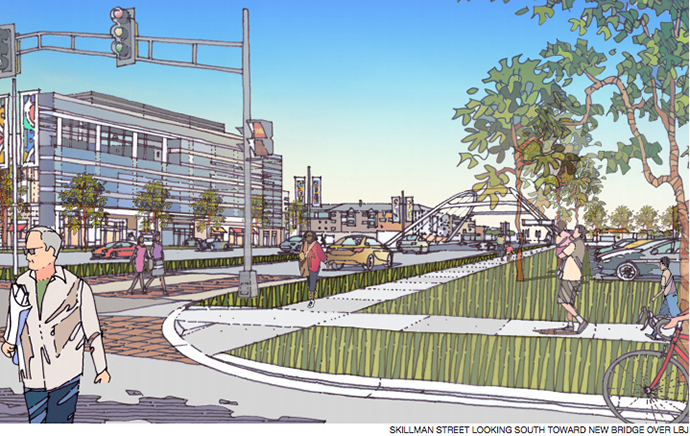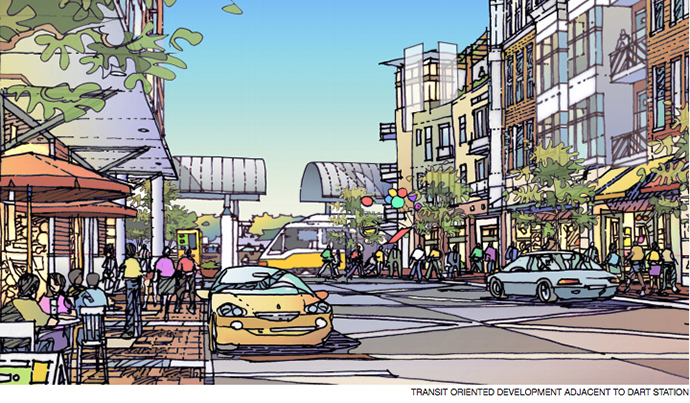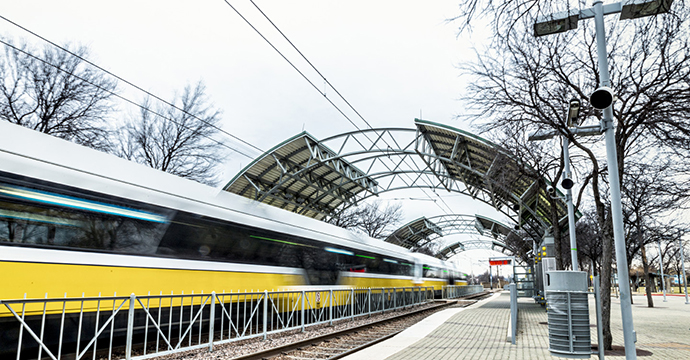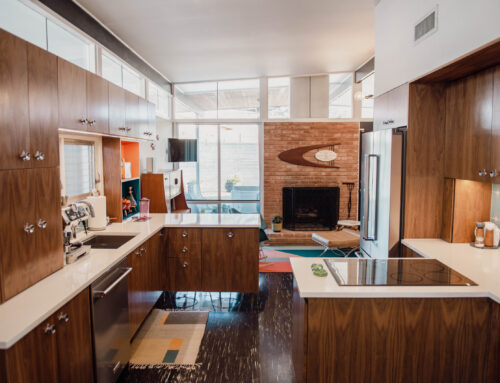A modern multiuse development, a new community center, bike paths and a vibrant retail scene around Skillman-635 — could it happen?
A vision for Lake Highlands: Part 2
When it comes to development in Lake Highlands, most of us think of Lake Highlands Town Center. That is understandable, but the focus on central Lake Highlands has obscured a quieter but arguably more consequential undertaking near its northeast gateway: a total revitalization of one of our neighborhood’s most problematic areas, 635-Skillman.
[quote align=”right” color=”000000”]See also: A Vision for Lake Highlands, Part 1[/quote]In the February Lake Highlands Advocate, we reported on the effort to realign a major traffic trouble spot, Skillman where it intersects 635. The Skillman realignment is the “linchpin” for a broader initiative to reimagine and develop the surrounding area, said Lake Highlands resident Susan Morgan, a member of both the LBJ-Skillman Interchange Task Force and the LBJ (635)-Skillman Urban Planning Initiative committees, in last month’s report. This month we take a closer look at possible development around the Skillman-635 intersection.

Both sketches by Omniplan show imagined redevelopment near Skillman-635. An anticipated new bridge along Skillman could be the catalyst for improvement in the area, urban designers say.

The Skillman-635 DART station is underutilized and offers an opportunity for a modern mixed-use space. Note about the illustrations: “These renderings are generic in nature and are intended to reflect the type of development, and redevelopment, desired in the area. These layouts reflect the vision of the community and represent what could potentially happen in the future if property owners desire to redevelop their properties,” according to the Urban Planning Initiative Study.
The DART station at Skillman and 635 includes work by local artists commemorating Lady Bird Johnson’s highway beautification project — station columns feature stylized tire-tread patterns, tables await picnickers, and native wildflowers line the parking lot and entrance.
Unfortunately, the station is isolated, underutilized and not very accessible.
But this DART station could be the centerpiece for a future transit-oriented, mixed-use development.
It is one of four pinpointed development opportunities in the 635-Skillman land-use study, adopted by the Dallas City Council last year as a guideline for development in the area, which includes approximately 703 acres bound by Forest Lane, Royal Lane-635, Atchison, Topeka and Santa Fe railroad tracks, and Arbor Park.
Based on a 2012 DART occupancy count, of the 733 spaces in the Skillman station’s park-and-ride lot only 104 spaces are typically used.
Imagine a future in which this desolate DART station, on the fringe of Lake Highlands, is a hotspot for shopping, working, beauty treatments, and patio dining — a place where people live in second-floor apartments; walk along safe, wide pedestrian paths; ride the DART rail to destinations citywide; or pedal along a convenient bike path with access to the region’s extensive trail network.
The benefits of such a development could extend to other areas of northeast Dallas and Lake Highlands, says Tip Housewright, whose firm Omniplan worked on both the realignment plan and the Skillman-635 vision plan, which includes goals for each of the four corners of 635-Skillman.
“This is really trying to create a new future for this district, something and much better [than what exists now],” he told a group of Lake Highlands residents recently. “Higher quality developments that work off the DART station and take advantage of the new intersection. You’ll have four corners that are much more useable.”
The community-led Skillman realignment project (outlined in the February issue) was the catalyst for the Skillman-LBJ Urban Planning Initiative Study, which proposes the aforementioned land-use changes, says Morgan, who helped recruit Housewright and his firm to work on the realignment and land-use studies pro bono.
“Once we started getting somewhere with the realignment project, it was suggested that we do a land-use study, which is what this is,” Morgan says. “Once you fix the transportation infrastructure, you will want to have some guidance on what you do with the land use around that.”
[quote align=”left” color=”000000”]“Once you fix the transportation infrastructure, you will want to have some guidance on what you do with the land use around that.”[/quote]The realignment could free up about nine acres of valuable land. Developers will see it as a new opportunity, Morgan says.
“This is what you call infill development,” she explains.
“Anyone can build farther out, sprawl, but undeveloped land inside the city, infill property, is more valuable.”
Suggestions within the study include a community center on Whitehurst, complementing The New Room/Feed Lake Highlands center and Quest Care Clinic as well as redeveloping aging gated apartment complexes and turning them into modern multifamily communities with publically accessible parks, trails and walkways.
This comprehensive land-use study, about 250 pages in all, was one of nine planning projects selected for North Central Texas Council of Governments funding in the amount of $44.8 million. It received an additional $9.6 million (20 percent of the grant) from the Skillman Corridor Tax Increment Finance (TIF) District because it aims to accomplish the same goals as a TIF district — identify redevelopment and transit-oriented opportunities, promote sustainable living and economic growth, and increase public safety.
Designs outline what the 635-Skillman area might look like in the future, Housewright says. The study takes into consideration copious research and data, including the results of a survey distributed to Lake Highlands and northeast Dallas residents, and public feedback from community meetings and workshops, as well as an analysis of existing conditions by a team that includes professionals in urban planning and design, city and Texas Department of Transportation (TxDOT) staff, architects, and all manner of representatives from Lake Highlands area organizations and businesses.
The Skillman realignment issue aside, the biggest obstacles in the 635-Skillman area, according to the study, are a surplus of outdated multifamily dwellings and retail that struggles to attract patrons.
Issues related to fragmented, congested and unsafe local streets run a close third.
“The predominant land use is multifamily and commercial. Most of the multifamily units are two-story apartment buildings that were built for single-use individuals,” according to the study. “These apartment buildings weren’t built with families in mind, so the area lacks infrastructure and basic community needs such as open space, parks and libraries.”
Though the majority of residents who responded to the survey indicated a desire for less density in the area, the land-use study allows for continued density. It does, however, recommend the elimination and redevelopment of older multifamily properties, in ways that “provide better access or quality open space.”
The housing vacancy rate in these north Lake Highlands-area properties is significantly higher than the city’s, a condition that indicates they are ready for redevelopment, according to the study.
Rather than gated apartment communities, the plan calls for mixed-use retail/residential communities with open, publicly accessible space.
[quote align=”right” color=”000000”]“These apartment buildings weren’t built with families in mind, so the area lacks infrastructure and basic community needs such as open space, parks and libraries.”[/quote]Existing businesses, like Denny’s and Taco Bueno at the southwest corner of 635-Skillman, would not be forced out.
“These buildings are shown in this vision as staying in place. If properties in the study area choose to maintain their current structures and uses, site planning for any adjacent new development should still encourage development patterns that can sustain a mix of activities.”
Segments of the plan focused on walkability and quality of life include more connectivity to the sprawling and attractive Richland College campus, north of Lake Highlands at Walnut and Abrams.
The land-use study was approved and adopted by the Dallas City Council in October 2014. That means that heretofore the city will consult the recommendations of this plan when any action is requested that would affect the 635-Skillman area.
“The fact is that we have this urban plan on paper, we have something to help us navigate this area. If you didn’t have it, someone could come along and build something you’d be stuck with the next 30 years,” Morgan says. “There are just so many positives about all of this that it’s hard to enumerate them all.”
Recommended reading:
• LBJ Urban Planning Initiative Study, for a detailed look at the possibilities for 700 acres of land surrounding 635-Skillman. Purchase a printed volume at the office supply store My Office at 9660 Audelia (214.221.0011).
• The Death and Life of Great American Cities, by Jane Jacobs. Released in 1961, it revolutionized modern city planning and architectural design. 635-Skillman improvement advocate Susan Morgan says she “found the book extremely inspirational. It’s about New York and Jersey, but it was fascinating because I was reading, going, ‘That’s Dallas.’ The concepts in that book help you make sense of why urban planning is like it is.”
This was the second installation of a multi-part series about the vision for Lake Highlands. We will explore more about implementation, as well as the details and timeline of the I-635 LBJ East Project, which is vital to the whole 635-Skillman vision, in future segments. Also look for stories about the upcoming District 10 City Council election and more. See the first installation, about the Skillman realignment and bridge project, in last month’s magazine.






